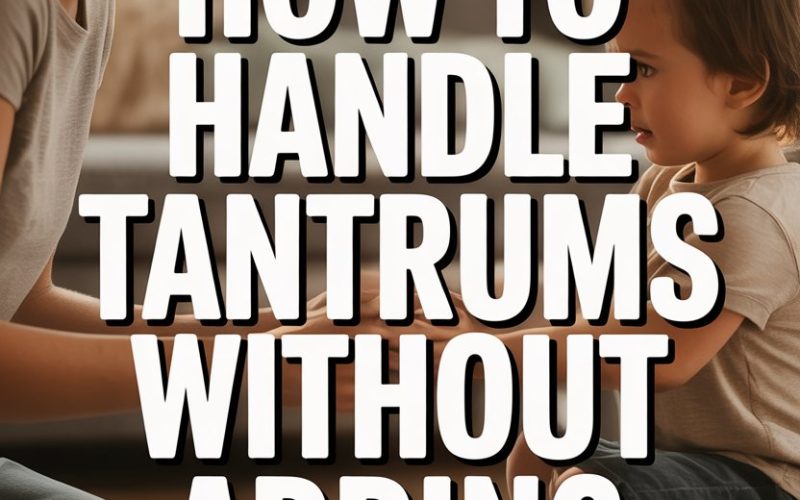A toddler’s tantrum is a bit like a summer storm: loud, unpredictable, and utterly inconvenient if you planned on getting anything done.
Most parents would take a root canal over another epic meltdown at the checkout line, and for good reason.
These emotional outbursts can test even the saintliest among us. Luckily, keeping your cool (and your dignity) is completely possible—without adding petrol to the fire.
Here’s how you can handle tantrums without making them grow arms, legs, and a vendetta.
Spot the Tantrum Before It Erupts
Every veteran parent has developed a kind of sixth sense—the “tantrum radar.” It might start as a furrowed brow, a whiny tone, or a refusal to eat anything but beige food.
Spotting the signs early can mean the difference between gentle redirection and an episode worthy of an Oscar.
Distraction works wonders before the volcano erupts. Offer a choice—“Would you rather help me with the peas or the potatoes?”
Sometimes, giving your child a sense of control (even if it’s the illusion of it) can stave off disaster. If you catch the early signals, a well-timed cuddle, snack, or change of scenery can nudge the mood in a better direction.
Keep Your Own Cool—Easier Said Than Done, But Crucial
Kids are emotional sponges. If you start huffing and puffing, they will, too, only with more volume and possibly some rolling on the floor for dramatic effect.
Take a slow, deep breath. If you must, pretend you’re about to blow out birthday candles.
This not only calms your nervous system but models emotional regulation—pretty nifty for tiny people learning how to ‘do emotions.’
Research shows parents who keep their cool during their child’s emotional hurricanes tend to have kids who can self-soothe better over time. If you need a moment, it’s perfectly fine to step away (safely) for a few seconds to gather yourself.
Don’t Reason With a Screaming Toddler
Ever tried to explain the Pythagorean theorem to a goat? That’s about as productive as reasoning with a three-year-old mid-tantrum.
When your child is caught in a wave of emotion, their logical brain has left the building.
Keep language simple and calm. “I see you’re upset. I’m here when you’re ready” is a classic.
No need to launch into lectures or explain the socio-economic reasons you can’t buy an ice cream truck on a whim.
Validate the Big Feelings
You might not relate to the heartbreak of being served toast in squares instead of triangles, but your child’s pain is real. A little validation goes a long way.
Try: “You’re angry because you wanted the red cup. It’s hard when things don’t go our way.”
Validation doesn’t mean you’re giving in, but it signals that you understand. Often, that’s all a child wants—to be heard, even if it’s about the tragic demise of triangle toast.
Get Down on Their Level—Literally
Children can find adults a bit intimidating, especially when voices rise. Kneel down and make eye contact.
This simple change feels less threatening, and more like a team.
A gentle touch on the shoulder or holding their hand can also help, if your child is the cuddly type. Some kids need physical space when upset, so respect their cues.
Stick to Simple, Consistent Boundaries
Tantrums love inconsistency. If your child’s been told “no lollies before dinner” but gets sweets after a dramatic display, expect repeat performances.
Boundaries are comforting, even when they cause fireworks in the short term.
Consistency is the gold standard. A phrase like, “When you’re calm, we can talk,” sung softly on loop, can reinforce your expectations without giving in to demands.
Over time, kids learn that tantrums don’t get them what they want—except maybe a bit of sympathy and a hug.
Hold the Lecture—Save It for Later
Once the storm has passed, it’s tempting to launch into a TED Talk about appropriate public behaviour. Resist. Right after a meltdown, children are emotionally spent, and your words will float away like bubbles.
Once everyone’s calm, a brief chat can help. “You were really upset at the park. Next time, let’s use words to tell me how you feel.” Keep it short and sweet.
The point isn’t to shame, but to help your child learn what to do next time.
Find the Hidden Triggers
Some children have very predictable triggers: hunger, tiredness, scratchy socks, the wrong cereal mascot glaring from the box. Keep a mental checklist, and where possible, head off the triggers before they turn into tantrums.
Offering a snack, or scheduling outings after a nap, can make the world of difference.
If you notice patterns—like meltdowns every time you leave the playground—give a five-minute warning and make goodbyes into a fun routine. Predictability helps kids feel safe.
Offer Comfort—But Don’t Bribe
Many parents are tempted to wave a chocolate biscuit as a peace offering. The trouble is, bribery works once, then you’re on the hook forever—like a loyalty card you never wanted.
Comfort comes in many forms: a hug, a favourite blanket, or just sitting quietly together. Acknowledge the feelings, offer support, and steer clear of using treats to stop tears.
Over time, your little one learns that comfort comes from connection—not from the biscuit tin.
When to Walk Away—Yes, Really
Some tantrums reach such operatic heights, the only thing left to do is make sure your child is safe and wait it out. If your presence is making things worse, or if you’re about to lose your cool, it’s fine to step back (again, safety first).
Children need to know it’s okay to feel big emotions, but also that you won’t join them on the floor screaming.
Standing by calmly—no eye rolling—shows that you’re the safe harbour, not another wave.
Apologise If You Lose Your Rag
Parents are human. Sometimes you yell, slam a cupboard, or say something you regret. It happens.
Kids don’t need perfection; they need adults who model healthy repair.
A simple, “I was feeling frustrated, and I yelled. I’m sorry. I’ll try better next time,” teaches responsibility, empathy, and trust.
Research from Zero to Three shows children who see grown-ups apologise feel more secure and are more likely to apologise themselves.
Call in Reinforcements
If tantrums are frequent, severe, or your child seems genuinely overwhelmed by their emotions, there’s no shame in asking for help.
Sometimes, underlying issues like sensory processing, anxiety, or communication delays are at play.
Chat to your GP, paediatrician, or child psychologist for support and guidance. Many parents find solace in parenting groups or trusted mates who’ve ‘been there, bought the T-shirt, and hidden it in the bin.’
Preventative Maintenance for Sanity’s Sake
Don’t wait for the next meltdown with dread. Sprinkle your daily routine with connection: five minutes of undivided attention, a silly game, or a snuggle.
Kids who feel seen and heard are less likely to unravel at the sight of green peas.
Prioritise sleep (for everyone), balanced meals (or at least a vegetable now and then), and downtime. When the family tank is full, tantrums lose a bit of their bite.
Laugh—Because Sometimes It’s All You Can Do
Parents are the masters of finding humour in chaos. Sometimes the sheer absurdity of a tantrum is all you need to crack a smile (at least on the inside).
Keep a mental highlight reel of the truly bizarre meltdowns—refusing to wear socks, wanting the blue bowl, the injustice of bedtime…
You’re not alone. Every parent has a story, and sharing them can make the journey feel a little less bumpy.
The Gift Hidden in the Meltdown
Tantrums aren’t just noise; they’re your child’s way of saying, “This is too much for me right now.”
Underneath the wails is a little person learning to handle disappointment, frustration, and all the tricky bits of being human.
Your job isn’t to fix every feeling but to show up, over and over, with empathy and clear limits.
One day, those stormy evenings will be a memory, and your child will have you to thank for teaching them how to weather life’s ups and downs—no fire extinguisher required.





